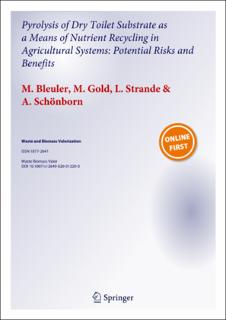Please use this identifier to cite or link to this item:
https://doi.org/10.21256/zhaw-20960Full metadata record
| DC Field | Value | Language |
|---|---|---|
| dc.contributor.author | Bleuler, Mira | - |
| dc.contributor.author | Gold, Moritz | - |
| dc.contributor.author | Strande, Linda | - |
| dc.contributor.author | Schönborn, Andreas | - |
| dc.date.accessioned | 2020-12-03T10:29:38Z | - |
| dc.date.available | 2020-12-03T10:29:38Z | - |
| dc.date.issued | 2020-10-20 | - |
| dc.identifier.issn | 1877-2641 | de_CH |
| dc.identifier.issn | 1877-265X | de_CH |
| dc.identifier.uri | https://digitalcollection.zhaw.ch/handle/11475/20960 | - |
| dc.description.abstract | Biochar is increasingly being applied as a soil amendment in agriculture. Biochar is typically produced from plant biomass and contains relatively low amounts of plant nutrients (e.g., N, P, and K), thus providing limited fertilizer value. Human excreta contains plant nutrients that could be recycled to create sustainable agricultural nutrient cycles. This study investigated the potential of biochar derived from a dry toilet substrate as soil amendment. The substrate consisted of urine, faeces, and wood chips, and was pyrolyzed at 500–650 °C for 10 min. The biochar was analyzed for plant available P, water leachable P and K, carbon stability, pH, electrical conductivity, polycyclic aromatic hydrocarbons (PAHs), polychlorinated biphenyls (PCBs), dioxins, and germination tests with barley and lettuce were conducted to estimate the biochar fertilizer value and potential bio-toxicity. The biochar contained 25.0 ± 1.0 g N/kg dry mass (DM), 33.1 ± 2.1 g P/kg DM and 20.7 ± 0.2 g K/kg DM. 65% DM P was extractable by formic acid solution, 31.7% DM P and 60.5% DM K were water leachable in a ten-day column water-leaching experiment. The biochar complied with European regulations for PAHs, PCBs, dioxins and heavy metal concentrations, except for Zn and Ni. Germination of salt-resistant barley was not affected by biochar doses < 50% DM, while salt-sensitive lettuce germination was inhibited at doses ≥ 2% DM, indicating that the dry toilet substrate biochar induced salt stress. Based on these results, it is recommended that urine separation should be considered for biochar of excreta, which could reduce salt stress while maintaining concentrations of “fixed” or bioavailable nitrogen. | de_CH |
| dc.language.iso | en | de_CH |
| dc.publisher | Springer | de_CH |
| dc.relation.ispartof | Waste and Biomass Valorization | de_CH |
| dc.rights | https://creativecommons.org/licenses/by/4.0/ | de_CH |
| dc.subject | Biochar | de_CH |
| dc.subject | Dry toilet | de_CH |
| dc.subject | Pyrolysis | de_CH |
| dc.subject | Germination test | de_CH |
| dc.subject | Nutrient recycling | de_CH |
| dc.subject | Sanitation | de_CH |
| dc.subject.ddc | 540: Chemie | de_CH |
| dc.title | Pyrolysis of dry toilet substrate as a means of nutrient recycling in agricultural systems : potential risks and benefits | de_CH |
| dc.type | Beitrag in wissenschaftlicher Zeitschrift | de_CH |
| dcterms.type | Text | de_CH |
| zhaw.departement | Life Sciences und Facility Management | de_CH |
| zhaw.organisationalunit | Institut für Umwelt und Natürliche Ressourcen (IUNR) | de_CH |
| dc.identifier.doi | 10.1007/s12649-020-01220-0 | de_CH |
| dc.identifier.doi | 10.21256/zhaw-20960 | - |
| zhaw.funding.eu | No | de_CH |
| zhaw.issue | 12 | de_CH |
| zhaw.originated.zhaw | Yes | de_CH |
| zhaw.pages.end | 4183 | de_CH |
| zhaw.pages.start | 4171 | de_CH |
| zhaw.publication.status | publishedVersion | de_CH |
| zhaw.volume | 2020 | de_CH |
| zhaw.publication.review | Peer review (Publikation) | de_CH |
| zhaw.webfeed | Ökotechnologie | de_CH |
| zhaw.author.additional | No | de_CH |
| zhaw.display.portrait | Yes | de_CH |
| Appears in collections: | Publikationen Life Sciences und Facility Management | |
Files in This Item:
| File | Description | Size | Format | |
|---|---|---|---|---|
| 2020_Bleuler_etal_Pyrolysis-of dry-toilet-substrate_Springer.pdf | 1.04 MB | Adobe PDF |  View/Open |
Show simple item record
Bleuler, M., Gold, M., Strande, L., & Schönborn, A. (2020). Pyrolysis of dry toilet substrate as a means of nutrient recycling in agricultural systems : potential risks and benefits. Waste and Biomass Valorization, 2020(12), 4171–4183. https://doi.org/10.1007/s12649-020-01220-0
Bleuler, M. et al. (2020) ‘Pyrolysis of dry toilet substrate as a means of nutrient recycling in agricultural systems : potential risks and benefits’, Waste and Biomass Valorization, 2020(12), pp. 4171–4183. Available at: https://doi.org/10.1007/s12649-020-01220-0.
M. Bleuler, M. Gold, L. Strande, and A. Schönborn, “Pyrolysis of dry toilet substrate as a means of nutrient recycling in agricultural systems : potential risks and benefits,” Waste and Biomass Valorization, vol. 2020, no. 12, pp. 4171–4183, Oct. 2020, doi: 10.1007/s12649-020-01220-0.
BLEULER, Mira, Moritz GOLD, Linda STRANDE und Andreas SCHÖNBORN, 2020. Pyrolysis of dry toilet substrate as a means of nutrient recycling in agricultural systems : potential risks and benefits. Waste and Biomass Valorization. 20 Oktober 2020. Bd. 2020, Nr. 12, S. 4171–4183. DOI 10.1007/s12649-020-01220-0
Bleuler, Mira, Moritz Gold, Linda Strande, and Andreas Schönborn. 2020. “Pyrolysis of Dry Toilet Substrate as a Means of Nutrient Recycling in Agricultural Systems : Potential Risks and Benefits.” Waste and Biomass Valorization 2020 (12): 4171–83. https://doi.org/10.1007/s12649-020-01220-0.
Bleuler, Mira, et al. “Pyrolysis of Dry Toilet Substrate as a Means of Nutrient Recycling in Agricultural Systems : Potential Risks and Benefits.” Waste and Biomass Valorization, vol. 2020, no. 12, Oct. 2020, pp. 4171–83, https://doi.org/10.1007/s12649-020-01220-0.
Items in DSpace are protected by copyright, with all rights reserved, unless otherwise indicated.